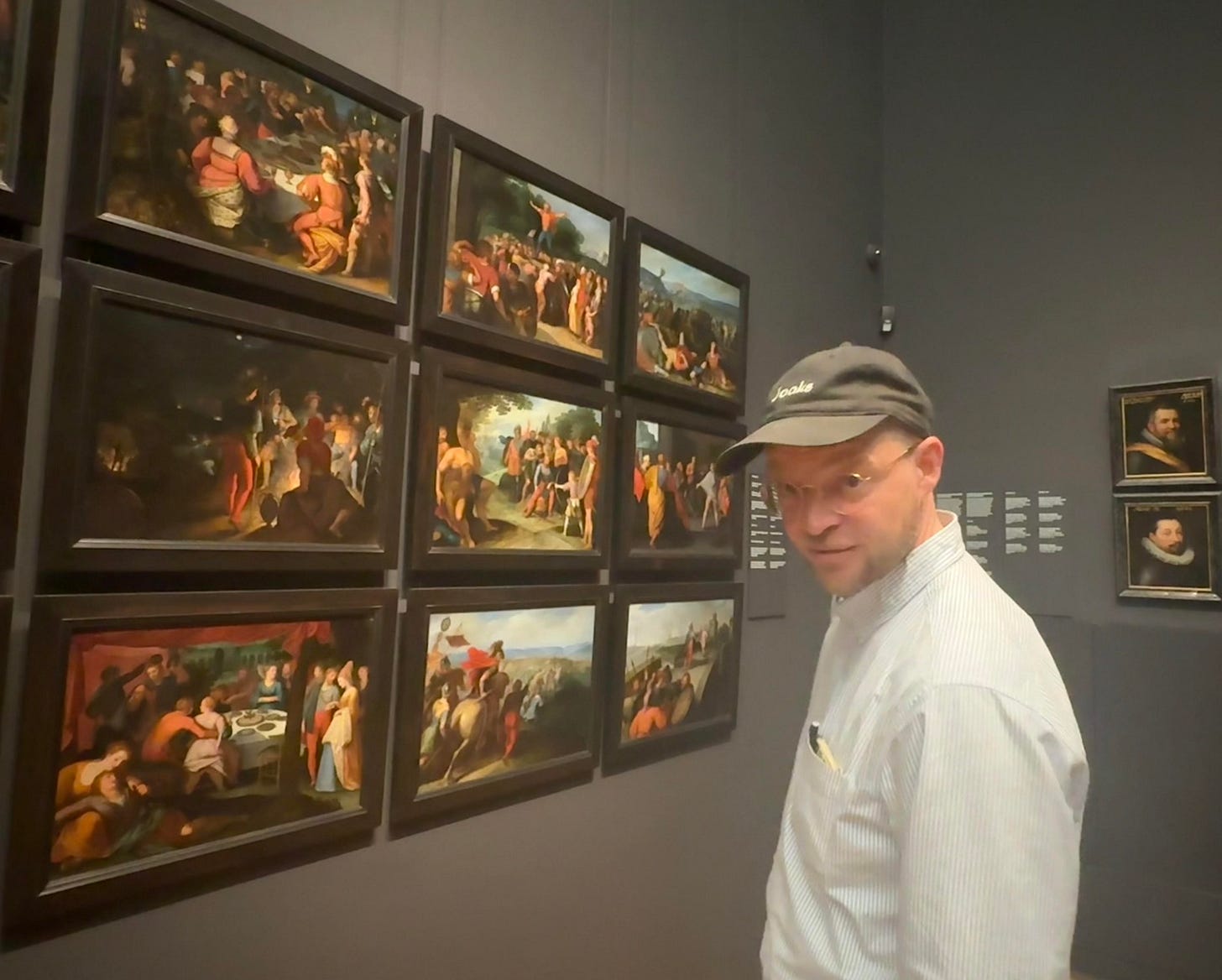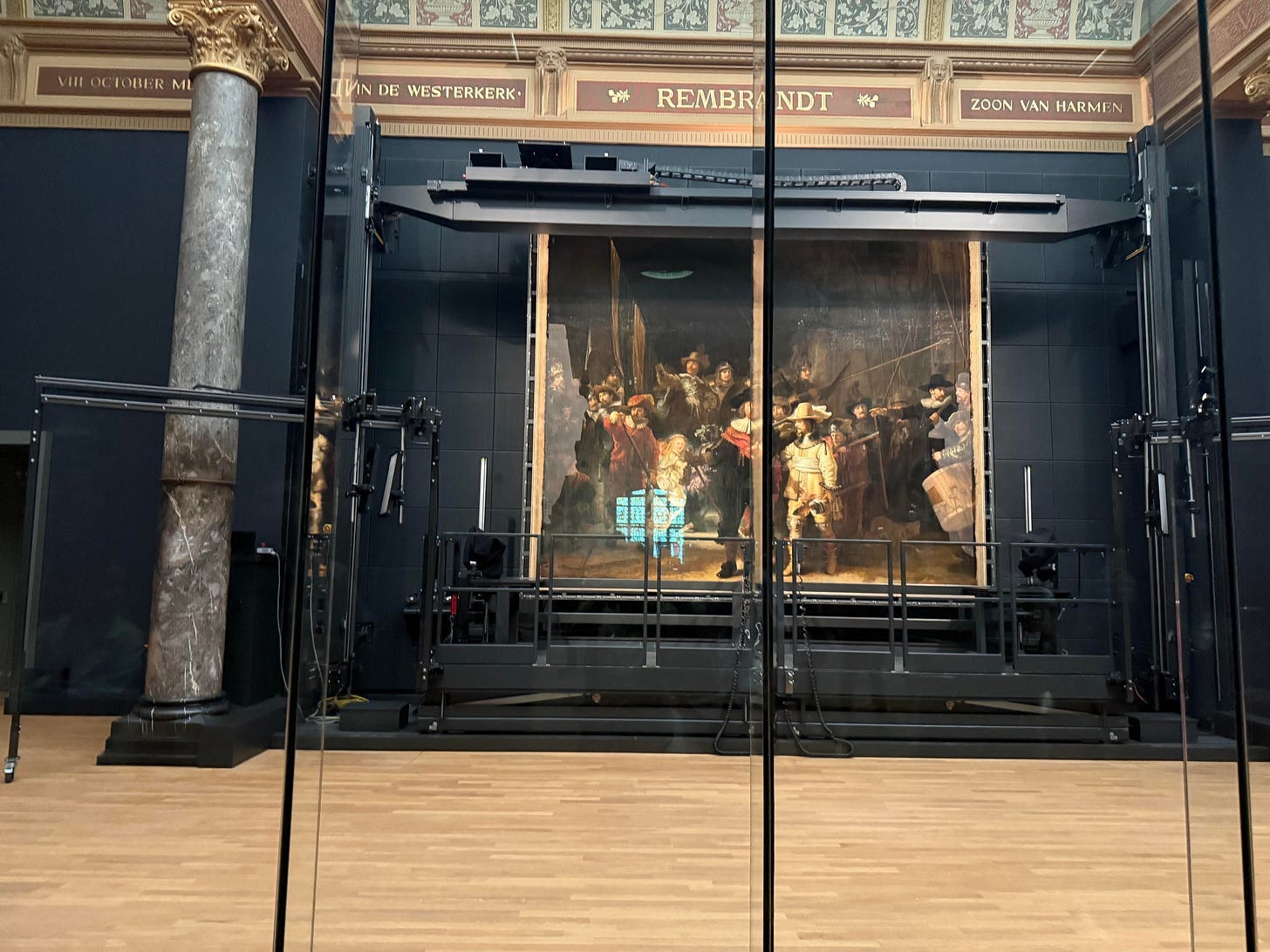In Amsterdam - looking at the “The Revolt of the Batavians” with German painter Wayne Horse!
The Baroque historical cycle of Dutch painter Otto van Veen (1556-1629) at the Rijksmuseum.
The Painter Willehad Eilers — also known by his pseudonym Wayne Horse — is a real gent. He is quite nearly the platonic ideal of the fastidious and intense German painter. Now in his early forties, the artist is a longtime acquaintance of several Dutch artists I know, and I got to know him better on this recent jaunt to Amsterdam. Slim, bespectacled, thoughtful and avuncular — Eilers is friendly and contained. He is also an exceedingly strong painter — one whose puckish and cerebral oeuvre is habitually described as “grotesque” by both admirers and critics. He often paints murals and his artistic patrimony is Amsterdam Royal Academy via a detour through the German graffiti scene. Though he is known for painting in several variegated styles, the gestural craftsmanship, irony and whirling energy of his canvases fall squarely within the garrulous tradition of Otto Dix. In fact, the discordant influence of the twenties generation of German painters that included Dix (one of his declared favorite painters) is obvious. The outdoor murals are potent and filled with tableaus of carnally explosive movement. His paintings are -— for whatever curious reason — huge in Korea.
Passing through Amsterdam this week, I accepted the painter’s generous invitation of a Saturday afternoon stroll through the Rijksmuseum. "I often walk into the museum just to see one specific painting” he informed me. “We have this card in Amsterdam, which allows you to visit the museums as often as you like. I feel at peace among paintings whose creators are long dead”.
Naturally, we arranged to meet in the Museum’s second floor gallery housing Rembrandt’s The Night Watch. The crown jewel of the Rijksmuseum collection (and perhaps of all Dutch art) is currently undergoing a decade-long, publicly viewable study and restoration process. Which is far from a lovely sight. A colonoscopy coupled with heart surgery conducted for the sake of public voyeurism could only be a degrading experience for all involved. The museum’s grandiosely named “Operation Night Watch” has encapsulated the painting in a carapace of construction cranes and specialized machinery, with viewers gawking at the painting set from half a room away behind plexiglass. One can barely make out any of the details from this far away. British and Dutch tour guides have to resort to zooming in on details of the painting reproduced on the iPads that they hold aloft over their heads. I find myself feeling nothing from across the room — except perhaps reverence for the fact that I had the chance to experience the painting authentically before it’s cocooning six year ago. It is a pity for the visitors who might never ever get closer than thirty feet.
“They imprisoned the painting behind bulletproof glass and made it into a Hannibal Lecter situation!” Eilers cracks.
He is not wrong.
We decide to dedicate our visit to an exquisite series of miniature historical paintings by the Dutch artist Otto van Veen (1556-1629). The humanist painter who had briefly tutored Rubens is known for his religious allegories, but he also excelled at mannerly depiction of historically mythologized scenes. The subject of the twelve painting baroque cycle, The Revolt of the Batavians against the Romans, took place in 69/70 AD along the Rhine delta. The Batavi were Romanized German tribes who had been incorporated into the Roman army as a caste of elite warriors and imperial bodyguards. The German tribe’s territories overlapped with present day Holland, which made the historical theme an obvious political precursor to the politics of that time. Painted over three years, the cycle was commissioned by the authorities of the 17th century Dutch Republic as a way to cleverly signal the historical parallels to their own noble struggle against a faraway empire. The Eighty Years’ War was still ongoing and the Netherlands were at that moment themselves in the middle of a revolt against Habsburg Spain.
Each of the delicately painted paintings in Van Veen’s cycle depicts a particular didactic moment in what would now be seen as an indigenous struggle against an overweening imperial power. In comic strip style — we observe the politicking, the banquets, the rousing speeches of rebel leaders. Quickly followed by battles scenes. The staccato arrangements of the cycle render it deceptively placid at first glance. The stately series is static and tranquil. Pedagogic. In perhaps the most remarkable painting of the cycle, Julius Civilis Having his Hair Cut after the Fall of Vetera, the victorious Roman General is being groomed and primped as he pensively observes his young son slinging arrows into captive Batvian soldiers. Eilers is as fascinated with the picaresque execution of the POWs as I am. “The general’s young son is wearing tight pants and torturing the captives with a bow and arrow as the big rosy-cheeked men are celebrating and blowing into horns. It is festive, but Julius stares into nowhere.”
Looking at art very intently along with a painter means concentrating on its technical aspects and painterly qualities. “When looking at old paintings, it is not the political context that captures me as a painter. I am far more interested in the physicality of the painting than in its historical context. I take in the atrocities, the fear, the lust, the joy. These emotions are timeless and we are still the same beast”. We discuss perspective and framing.
An outing with an art world pro also means concentrating on less aesthetically pleasing aspects of the vocation. “Visits to contemporary art museums are very rarely enjoyable to me. Here in the Rijksmuseum, I do not feel any sense of competition. I do not wonder why a particular piece has been included in the Museum. I feel free to just take the art in. There are too many open ends and unresolved positions, modern issues that bother me in a modern art museum. I often get disturbed and annoyed by the agenda of the museum. This is not the case with old masters. I can simply sit and enjoy them."
Rembrandt’s intimate banquet setting of the same theme The Conspiracy of Claudius Civilis - would be completed a half century later. It was a massive canvas before Rembrandt decided to trim it down in order to sell it. Being his final attempt at secular painting it was strikingly different from the miniature self contained crowd and battle scenes of his predecessor. Rembrandt depicts the mammoth one eyed German rebel leader as a beastly and biblical figure - which is more or less in line with the way Tacitus described him in the Histories. For Van Veen, the Romanized and romanticized rebel is a proto- Dutch nationalist who cuts an elegant and trim figure (with two eyes). When he faces his Roman General counterpart across a bridge in the cycle’s final painting, their matching legionnaire armor is more redolent of the Roman civil war aspect of the uprising. They are political equals.
Eilers points out the placid illustrative aspect of Van Veen’s cycle. “There is no passion in the depicted drama, nor in the manner in which it is painted” he points out reasonably. “It seems like the scenes were merely chosen for their apriori proven meaning and historical context. The painter is not searching for emotions. He is merely playing the established keys for their information value”.
Our dialogue must seem to be really truly inviting (or perhaps I am being too loud in public as occasionally happens when I become overexcited about art or ideas). We begin to notice that museum goers are jostling around us discreetly to listen in to our conversation. A middle aged Canadian gentleman wants to know if we are art historians. A comely Russian hippie girl living in Greece wants to join our dialogue - and perhaps for a drink afterward.
Finally, I point out that Van Veen’s cycle is understandably demure about the ultimate victory of the Roman army over the rebels. A certain historical veracity is missing. Eilers is having none of my pedantry. “For me” the artist concludes emphatically “this painting is far more than the just (the mere) information it proffers. For me personally, this painting shows the ever-present, yet somehow, continually surprising capability of humans to completely dehumanize one another. That and it has a decent feel for swag!"





